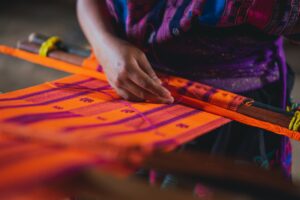
Embroidery work is a decorative process that involves stitching patterns, designs, or images onto fabric using a needle and thread. It is a traditional and artistic form of embellishment that can be found in various cultures and has evolved over centuries. Embroidery can be done by hand or with the help of embroidery machines for more intricate or mass-produced designs.
Here are some key points about embroidery work:
- Materials:
- Thread: Various types of threads can be used, including cotton, silk, wool, and metallic threads.
- Fabric: Embroidery can be done on a wide range of fabrics, such as cotton, linen, silk, and denim.
- Techniques:
- Hand Embroidery: This is the traditional method where the embroiderer manually creates the design using a needle and thread. Common hand embroidery stitches include satin stitch, running stitch, chain stitch, and cross-stitch.
- Machine Embroidery: Utilizes computerized machines programmed to create intricate designs automatically. This is often used in mass production but can also produce highly detailed and precise work.
- Types of Embroidery:
- Crewel Embroidery: Typically uses wool on a plain weave fabric, often creating intricate floral patterns.
- Cross-Stitch: Involves creating X-shaped stitches to form a pattern or image on even-weave fabric.
- Bead Embroidery: Combines traditional embroidery with the addition of beads for texture and embellishment.
- Cultural Significance:
- Embroidery often holds cultural and historical significance. Different regions and communities have distinct embroidery styles and techniques that reflect their traditions and identity.
- Applications:
- Apparel: Embroidery is commonly used to embellish clothing items such as shirts, dresses, and traditional garments like sarees and kurtas.
- Home Décor: It’s employed in decorating household items like pillow covers, tablecloths, and curtains.
- Accessories: Embroidery adds a touch of elegance to accessories like handbags, hats, and scarves.
- Personalization:
- Embroidery allows for a high degree of personalization. Names, monograms, or specific designs can be added to items to make them unique and special.
- Artistic Expression:
- Many artists use embroidery as a form of artistic expression, creating intricate and visually appealing pieces that are valued both for their craftsmanship and artistic merit.
Embroidery work is a versatile and enduring craft that continues to be appreciated for its beauty, cultural significance, and the skill involved in its creation.
